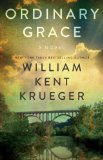Summary | Excerpt | Reviews | Beyond the book | Read-Alikes | Genres & Themes | Author Bio

William Kent Krueger's latest novel is an atmospheric murder mystery set in a fictional small town in Minnesota. The tragedies that unfold during the summer of 1961 are described forty years after by the now 53-year-old Frank Drum. The eldest son of the town's Methodist minister, Frank was 13 at the time five people who lived in the area died under suspicious circumstances. Along with reporting on the fatalities and the investigations that surround them, Frank vividly describes what it was like to be a kid in middle America during that era, the colorful characters that populated the small town, and the lasting impact the deaths had on his family and others.
I tend to avoid novels where children are the main characters, as I seldom find their thoughts, conversations or actions credible over the length of the book; in my view, they generally come across as too worldly or precocious. Krueger's choice of protagonist, though, is perfect. By having the older Frank tell the story of his younger self, he allows for the immature decisions of his character while keeping the maturity embedded in the narrative from seeming dubious or out of place. Truly Frank is one of the more irresistible narrators I've come across in a long time, and the author skillfully conveys a young boy's confusion and angst from the perspective of adulthood; this character sucked me into the story and didn't let go until the end.
The highlight for me, though, was the marvelous sense of time and place Krueger created throughout the novel. As a child of the 60s and a Midwesterner, I could absolutely picture the summertime scenes the author painted. The entire novel is a perfect snapshot of an idyllic time in a prosperous and peaceful United States.
There was a parade that afternoon as there was every Fourth of July. The high school band marched in their braided uniforms and so did members of the VFW, many of them dressed in the military finery in which they'd served. The firemen drove their trucks, and the mayor and other city politicians rode in cars and waved, and there were flatbeds made into floats and hauled behind pickups cleaned and waxed for the day… and even kids joined in the parade, pulling their pets or small siblings behind them in Radio Flyer wagons decked out in crepe of red, white, and blue… [The park] was full of vendors selling cotton candy and hot dogs and bratwurst and mini-donuts and helium-filled balloons…There were games with prizes and there were polka bands and a temporary dance floor that had been laid out in the grass.
The author takes his time setting the scene and establishing his characters, and consequently the murder at the heart of the novel, which occurs halfway through the narrative, takes some patience to reach. Although red herrings abound, it is relatively easy to figure out "whodunit" long before the plot's denouement; the mystery is, however, satisfying enough to hold most readers' attention throughout.
A strong religious thread runs through the novel, and one of the major themes of the book is the role faith can play when unthinkable tragedy occurs. Although the narrator's family is Protestant, the spiritual message is more inclusive than a Christian-themed book might be, leaning more toward belief in God as a provider of comfort than in Jesus Christ. The end result is that the ideas at the book's core will appeal to Christians and non-Christians alike. And, while the faith-based portions are central to the novel, they're not presented in a heavy-handed, "preachy" manner. As someone who doesn't consider herself a person of faith, I found these sections of the book to be touching rather than overbearing or lecturing.
The author goes out of his way to portray New Bremen's characters as covering a broad spectrum of society. His milieu comprises the man of God, the local alcoholic, the emotionally wounded war vet, the angry Native American, the itinerate, the town bully, the cold rich person, the talented loner, persons with disabilities – and on and on, including just about every type of individual one can think of. Unfortunately, the end result of trying to be so comprehensive is that many of these characters are stereotypical and clichéd. It's not that they're poorly described or one-dimensional really; it's more that they're formulaic, with predictable actions that detract from the otherwise fine writing. The narrator is the exception to this, and the skill with which his character and a few others are drawn makes up for the unexceptional nature of the minor players in the drama.
Overall Ordinary Grace is an entertaining mystery with some rather emotional content at its heart. In addition to an engaging plot, the book is thought-provoking and, at times, quite poignant. Those looking for a character-driven mystery with content that goes beyond the standard police procedural will find this one worth perusing, and book clubs in particular will find it provides many topics for discussion.
![]() This review
first ran in the April 17, 2013
issue of BookBrowse Recommends.
This review
first ran in the April 17, 2013
issue of BookBrowse Recommends.

If you liked Ordinary Grace, try these:

by Liz Moore
Published 2024
When a teenager vanishes from her Adirondack summer camp, two worlds collide.

by William Kent Krueger
Published 2022
The author of the instant New York Times bestseller This Tender Land returns with a powerful prequel to his acclaimed Cork O'Connor series - a book about fathers and sons, long-simmering conflicts in a small Minnesota town, and the events that echo through youth and shape our lives forever.
Your guide toexceptional books
BookBrowse seeks out and recommends the best in contemporary fiction and nonfiction—books that not only engage and entertain but also deepen our understanding of ourselves and the world around us.